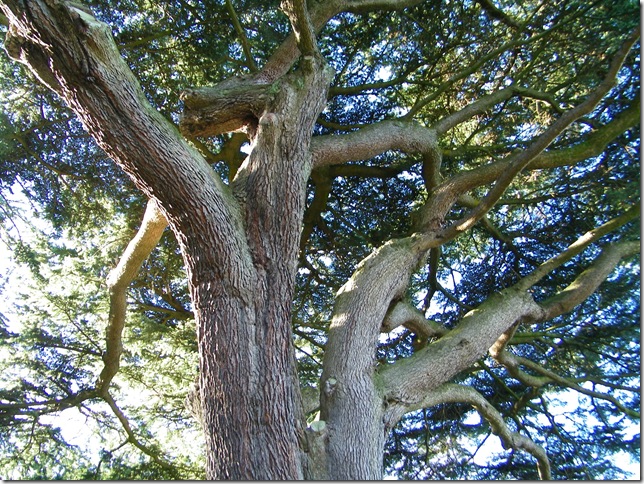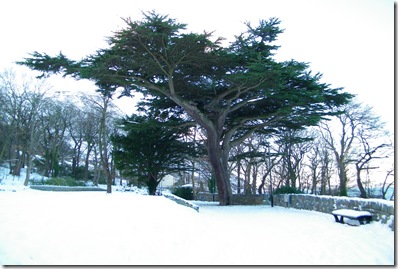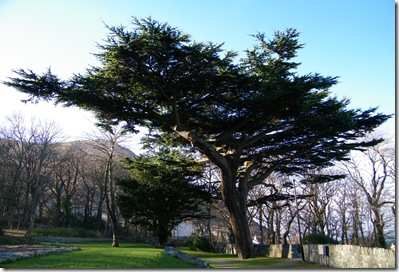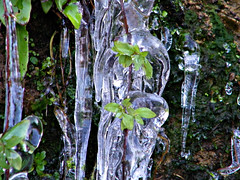Trees have always fascinated me, their shapes, branches, crowns and trunks are very varied, no matter if it is a fruit tree, pine tree, oak tree, silver birch or any other type of the many thousands of varieties of trees we find in our surrounding area.
I have made a habit of looking for unusual trees in my local area and surprisingly have found some very interesting species. In my earlier Blogs I have mentioned Crinodendron hookerianum ( Chinese Lantern Tree) and Cornus kousa Tree, which originate from as far as Asia and South America. How amazing to find them growing right here, on my door step.
The Cedar of Lebanon is another fine tree, growing in our local park. It is quite distinct for it’s characteristic shape and stands proud in the park, where I have taken photographs of it in different seasons. It seems to like the micro-climate we enjoy here on the coast of N.Wales and it looks very much established in years, if the size of the trunk is anything to go by.
This tree is just beautiful to look at, in any season.
Cedar of Lebanon in December
Cedar of Lebanon in February
Excerpts from Wikipedia: (english)
The Cedar of Lebanon was important to various ancient civilizations. The trees were used by the Phoenicians for building commercial and military ships, as well as houses, palaces, and temples. The ancient Egyptians used its resin in mummification, and its sawdust has been found in the tombs of Egyptian Pharaohs. The Sumerian Epic of Gilgamesh designates the cedar groves of Lebanon as the dwelling of the gods to which Gilgamesh, the hero, ventured. Hebrew priests were ordered by Moses to use the bark of the Lebanon Cedar in circumcision and the treatment of leprosy. The Hebrew prophet Isaiah used the Lebanon Cedar as a metaphor for the pride of the world.[13] According to the Talmud, Jews once burned Lebanese cedar wood on the Mount of Olives to celebrate the new year. Foreign rulers from both near and far would order the wood for religious and civil constructs, the most famous of which are King Solomon's Temple in Jerusalem and David's and Solomon's Palaces. Because of its significance the word Cedar is mentioned 76 times in the Bible, and played a pivotal role in the cementing of the Phoenician-Hebrew relationship. Beyond that, it was also used by Romans, Greeks, Persians, Assyrians and Babylonians.
Over the centuries, extensive deforestation has occurred, with only small remnants of the original forests surviving. Deforestation has been particularly severe in Lebanon and on Cyprus; on Cyprus, only small trees up to 25 m (82 ft) tall survive, though Pliny the Elder recorded cedars 40 m (130 ft) tall there.[14] Extensive reforestation of cedar is carried out in the Mediterranean region, particularly Turkey, where over 50 million young cedars are being planted annually.[15] The Lebanese populations are also now expanding through a combination of replanting and protection of natural regeneration from browsing by goats, hunting, forest fires, and woodworms.[16]
Historically, there were various attempts at conserving the Lebanon Cedars. The first was made by the Roman Emperor Hadrian, who issued a decree protecting parts of the Cedars of Lebanon in CE 118. In the Middle Ages, the Mamluk Caliphs also made an attempt at conserving the Cedars and regulating their use, followed by the Maronite Patriarch Yusuf Hbaych, who placed them under his protection in 1832. In 1876, Britain's Queen Victoria financed a wall to protect the Cedars of God (near Bsharri) from the ravages of goat herding.
Auszuege von Wikipedia: (german)
Für die Phönizier galt die Libanon-Zeder als Königin des Pflanzenreiches. Sie nutzten Zedernholz unter anderem zum Schiffbau. Auch die alten Ägypter nutzten Zedernholz für ihren Schiffbau, wobei vermutet wird, dass sie diese aus dem Libanon importierten. Der israelitische König Salomo soll die Zedern literarisch geehrt haben: Er dichtete von den Bäumen, von der Zeder auf dem Libanon bis zum Ysop, der aus der Wand wächst (1 Kön 5,13 EU). Darüber hinaus kaufte er sie für den Bau des später so genannten Salomonischen Tempels in Jerusalem (1. Kön. 5,20 EU u.ö.).
Infolge eines bereits in phönizischer Zeit begonnenen Raubbaus finden sich nur noch wenige alte Bäume im Libanon-Gebirge, sechs der dichtesten Waldgebiete liegen innerhalb des Nationalparks Chouf Cedar Reserve,[1] davon haben die Waldinseln bei den Dörfern Barouk und Maaser ech-Chouf die größte Zahl alter Bäume. Es besteht ein Programm zum Erhalt und zur Neuaufforstung.[2]
Die Symbolik beschreibt Rania Masri ausführlich 1995 auf einem Kongress des MIT, wiedergegeben in einem Artikel in Europa: „Über die Bedeutung und die Bekanntheit der Libanon-Zeder sowie ihre Behandlung“.[3]
Auch in der Türkei finden Aufforstungen von 300 km² jährlich statt.
Inzwischen wird die Symbolik auch in Deutschland aufgegriffen: die Stadt Marl pflanzte auf Vorschlag der CIAG Marl im Rahmen des 7. Abrahamsfestes 2007 einen solchen Baum, um den Frieden zwischen den Weltkulturen und den Religionen zu bekräftigen.[4]




